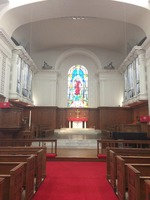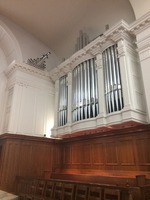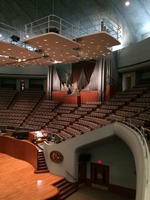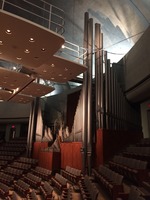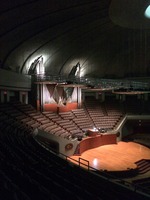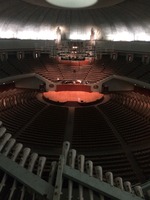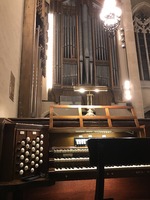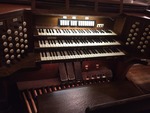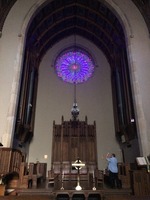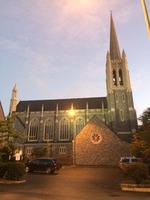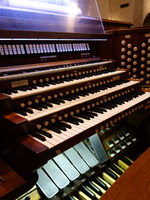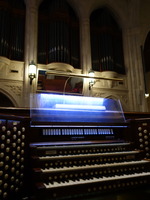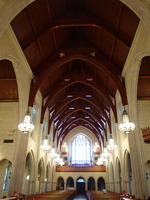The next recording is “in the can.” (Young folks don’t know what a can is. Nowadays, a recording is just on a hard drive somewhere.) Anyway, this summer so far has included four days on Aeolian-Skinner Op. 912A (1949) at First Presbyterian in Houston to record Widor Symphonies 1 and 5. This will be one of seven CD installments presenting all ten Widor Symphonies, plus his handful of other works for organ solo.
This multi-CD project has evolved, as explained here. In my efforts to match repertoire to organ, I knew that the Widor 5th needed to be recorded at FPC Houston. When I first moved to Houston for grad school in 1990, I heard then-incumbent Harold McManus play the entire 5th on a recital at the church. Every year or so, Harold would present a Sunday evening recital, and the church media team would set up a HUGE screen for everyone to see what was going on at that horribly hidden console. It was during recitals such as these that I was introduced to the Roger-Ducasse Pastorale (which I have performed ever since), the Bach canonical variations on Vom Himmel hoch (which I have not), and the REST of the Widor 5th beyond the Toccata.
Imagine my thrill and humility to be able to succeed Harold as organist of the church in 1997, where I continued the large-screen recital tradition and tried to play as beautifully and as sincerely as he did. The recitals were far easier to play than to assume Harold’s heart in service playing. When the time comes, I will dedicate this recording to his memory. It’s the best I can do, and it’s the least I can do.
Aeolian-Skinner Op. 912A is the second Aeolian-Skinner built for this church. Op. 912, ca. 1933, is in the chapel, in quite its original condition after a handsome Schoenstein rebuild in 1993. That organ was moved from the original downtown campus to the present campus in 1948. When Aeolian-Skinner had a second project on the same site, the opus number was kept the same and added a letter. Hence Opp. 912 and 912A are on the same campus but separated in age by 16 years.
The building is a traditional Georgian exterior, and the room is a Calvinistic-white marble space with a divided chancel and the longest nave aisle in town. (Brides faint on their way down.) It really is one of the more stunning spaces for traditional worship I have ever seen. And it still looks good despite the FIVE camera perches retro-fitted into the space. The sound system is unobtrusively installed, and there are no projector screens. (Keeping fingers crossed there.) The organ is a side installation with no pipes showing, and the console is across the chancel from that, high above the choir stalls. [Rumor has it that the pastor who built the building was determined that the organist was no longer going to be able to escape during sermons.] Op. 912A is a handsome 3-manual, 72-rank beauty with full principal choruses on all divisions, including an 8’ Diapason on each manual, plus Diapasons I and II on the Great. Two Great mixtures. Great reeds are enclosed in the Choir. Fully independent Pedal principal stops all the way through a mixture, and a huge Bombarde at 16, 8, and 4 that Harold McManus affectionately nicknamed “Fafner.” Schoenstein performed a comprehensive rebuild of this organ in 1993, retaining everything imaginable, including the winded console – the combination system has the most delicious pneumatic ker-chunk to it with the punch of every piston. Schoenstein also added a Choir mixture, a Tuba in the Choir, and a Great Harmonic Flute. They moved the Swell 16’ Fagotto to the Pedal and replaced it in the Swell with a 16’ Contre Trompette that is worth its weight in gold. They also added two Walker 32s, which rumble the choir stalls, which helps recruit more choir members to sit near them.(!) Read more about the organs here.
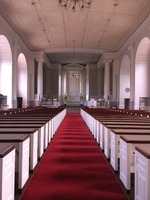
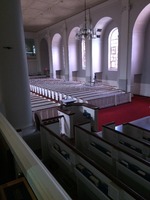
************************************
So on June 12, 2017, after a very early morning flight followed by a delicious Texas breakfast near Hobby Airport, I arrived at the church to begin registering. It is not difficult to register Widor; there are large swaths of stops, and the dynamic terracing of French organ music makes things easy.
But only on French organs.
On anything else, you have to “orchestrate” things a bit more. These days, I normally have the voicing of an Orgelbewegung Casavant in my ears, and to arrive back at my old stomping ground and to hear the richness of this organ was a culture shock. Nevertheless, the music at hand demands a much thicker richness than I remember this organ delivering. True to form of American Classic, no single stop is commanding, but lots of them in combination brings forth a sonic thrill not heard just anywhere else. And so the registration quickly got “interesting,” and I found myself supplementing Widor’s requirements more than I ever thought I would on this organ:
-- Widor’s voix cèleste was huge and commanding, and the swell box was thick and could keep it under wraps as desired. How to simulate that on an American Classic organ? Add the Swell Diapason 8!
-- During my service playing days on this organ, I used the Pedal Principals only in large combinations, but with Widor, they are on most of the time. It was utterly shocking to compare my use/disuse of those stops in church vs. in Widor. But his music works with them, and we needed the gravitasse.
-- Widor is sometimes vague about manual couplers. And so I was vague right back. Every now and then, I set up a three-manual texture, where each manual had its own character, but the buildup was nevertheless present and audible.
-- What should I prepare as “tutti?” There are super- and sub-couplers on the organ. I never touched the supers. But I used the sub-couplers religiously. As did Widor. And his music is perfect for it. The Toccata, with the resulting 32-foot manual stops is rather glorious. And the fullness of the Pedal division keeps it from being so top-heavy as it can be all over this country. Fafner does his job well.
-- As things evolved during recording week, we removed many of the flutes from fuller textures, much as we would on a Fritts. This gave the 5th Symphony a certain clarity that will make it sound like an entirely different organ from the 1st Symphony.
I quick-patched a whistling air leak in a concussion bellows. It was mild during the recording of the 1st Symphony, but by the time we started to record the 5th, it had become stentorian. Consequently, one may be able to hear that whistle during the 1st but not during the 5th. Thank goodness it got bad between Symphonies, rather than between movements. And thank goodness we recorded a full Symphony at a time. I’m looking forward to hearing engineer Ryan Edwards’ surgical removal of that whistle as needed in the 1st.
The most interesting part of this particular project was in managing the air conditioning. This building was built in 1948, and the air conditioner for it is rumored to be Houston’s oldest system still in operation. Which means it is loud. Very loud. Ear-splittingly loud through an engineer’s microphones. But it was going to be 90 degrees all week, with Houston’s usual 90% humidity. What to do? We knew that we HAD to have the air completely off for sessions (and that quiet is indeed heavenly), but the organ was going to drift in tuning after about 40 minutes. My producer and engineer, Keith Weber and Ryan Edwards visited the church a week before and made some notes about what happens when. Their solution was brilliant – leave the air on all night, and then cycle it on and back off every hour throughout the day. So it was turned off on all odd-numbered hours and then came back on during all even-numbered hours. The real stroke of brilliance there was that the air-on hours gave us an hour to prepare for the next air-off hour, which dramatically cut down on in-session coaching and patching. It also gave us time to rest body and mind. We just might do things that way in the future now, air or not. We got all twelve movements from these two Symphonies recorded in only 12 hours, spread across three days with plenty of rest.
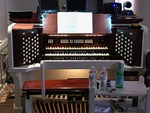
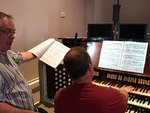
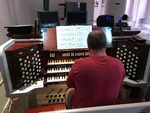
Thanks are due the physical plant guys from the church, who programmed the air conditioner without a hitch. Thanks are certainly due Rhonda Furr, FPC organist, for her gracious hospitality. And to the office staff, for getting us going in the first place. It was good to be back and to hear this organ play music I had never played on it, beyond the Toccata.
I'll address the $28,000 question now: the Toccata is played at 100 bpm, just like Widor marked it and recorded it. We all should.
 Thursday, June 14, 2018 at 11:14AM
Thursday, June 14, 2018 at 11:14AM  Joby Bell | tagged
Joby Bell | tagged  Widor recordings
Widor recordings 
